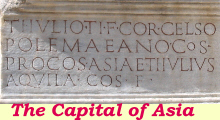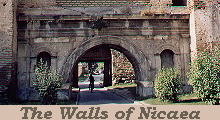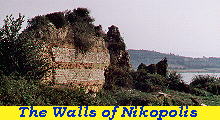

What's New!
Detailed Sitemap
All images © by Roberto Piperno, owner of the domain. Write to romapip@quipo.it. Text edited by Rosamie Moore.
Page added in April 2006.
|

 - Ephesus - Ephesus
(inscription in the Library built by Consul Julius Aquila to celebrate his
father Julius Celsus Polemenus, proconsul of Asia)
Byzantine Ephesus
Via Arcadiana
Ephesus shows very interesting signs of the transition from the Roman to the Byzantine period.
In 395 Emperor Theodosius left the empire to his sons Arcadius and Honorius: the former received its eastern part, while the latter had the western one.
It was a formal partition of the empire, not just an allocation of responsibilities.
For this reason a restoration by Arcadius of the large street between the
theatre and the harbour was celebrated by dedicating
the street to him.
It is interesting to observe that in Rome inscriptions on the gates restored by Honorius
celebrated both emperors.
During the reign of Justinian, Eastern Roman Emperor from 527 to 565, five columns, taken from the ancient buildings, were
rearranged along Via Arcadiana: four of them supported statues of the four Evangelists,
while the fifth one was placed upon a high base and most likely supported a cross (the image used as background for this page shows a relief of this base).
(left) Roman building which hosted the Councils; (right) baptistery
Maybe because Ephesus had been so important to the worshippers of the ancient gods, it was
chosen in 431 and 449 to host two ecumenical councils. They were held inside a
long Roman building, located near the harbour, which most likely was used as a
covered market: in the early Vth century some of the buildings had been turned into a church
which included a baptistery. The ceremony required the full immersion of the
neophyte and the steps leading down to the sunken receptacle are still visible.
The councils declared that Nestorianism (in 431) and Monophysitism (in 449) were heretical doctrines;
both decisions led to divisions among the Christians.
Nestorianism: doctrine stating that there were two separate persons in Christ, one human and one divine.
Monophysitism: doctrine stating that there is only one inseparable nature (partly divine, partly and subordinately human) in the person of Christ. Seljuc and St. John's Cathedral
Stones and columns from the Artemision were used to build walls and mosques
Some of the inhabitants of Ephesus lived near the Artemision, which was
located a couple of miles out of town.
The sanctuary was surrounded by facilities for the visitors such as
inns, baths, shops and by the houses of those who worked at the sanctuary. In the IIIrd century for the first time barbarian tribes managed
to cross the borders of the empire and to raid the rich province of Asia. These raids
became more frequent in the following centuries and gangs of local bandits increased the
risk of living near the Artemision. The site was abandoned
in favour of a more defendable nearby hill (today's Seljuc).
The ancient sanctuary was dismantled stone by stone (in a process which lasted centuries) and its
columns, reliefs, entablatures and arches can be seen in the walls and buildings of Seljuc.
Persecution Gate
In the VIth century Emperor Justinian in an effort both to stamp out paganism and
to compensate the Ephesians for the economic loss due to the closure of the Artemision,
decided to build a large basilica on the assumed tomb of St. John Evangelist.
The gate leading to the church was most likely the result of relocating
there the entrance of a Roman building (including the relief which decorated it).
It portrayed Achilles killing an enemy, but eventually it was thought to depict a gladiator killing a Christian martyr,
hence the name given to the gate.
St. John's Basilica
The basilica was a very large building divided into three naves with an apse at its western end.
The red and white masonry reminds the viewer of the walls of Constantinople
owing to the typical Byzantine practice of alternating layers of stones or marbles and
layers of bricks.
(left) Fortress of Ayasoluk; (right) a sort of chapel (having the shape of a temple) in the basilica
For a certain time St. John's Basilica attracted pilgrims and contributed to the growth of
Aghia Theologos, as the small
town was most likely known (when it fell in Ottoman hands the name was turned into Ayasoluk and eventually into Seljuc).
It attracted the remaining inhabitants of Ephesus, the harbour of which was completely
silted. Another factor which greatly reduced the population was a pestilence recorded as the Plague of Justinian. The initial outbreak originated in Egypt which supplied
massive amount of grain to Constantinople (and Rome): in 541 the plague spread to port
cities around the Mediterranean; the exact population loss is difficult to assess, but it was very
significant and it greatly weakened the Byzantine Empire.
Byzantine pluteus (parapet) and capital
In St. John's basilica a screen separated the aisles from the choir: it was made of plutei or transennae,
marble slabs decorated with a very light relief, usually of a very simple albeit
elegant design. These plutei are peculiar to Byzantine art as well as the simple and low
capitals which supplemented those taken from the Artemision.
Return to Roman Ephesus.
Clickable Map of Turkey showing all the locations covered in this website (opens in another window).

SEE THESE OTHER EXHIBITIONS (for a full list see my detailed index).
  
|